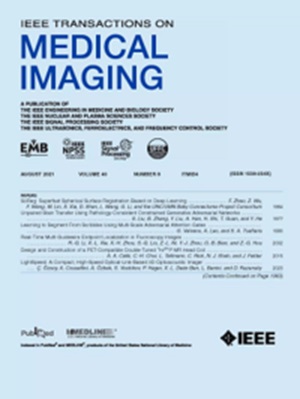An On-Board Spectral-CT/CBCT/SPECT Imaging Configuration for Small-Animal Radiation Therapy Platform: A Monte Carlo Study
IF 8.9
1区 医学
Q1 COMPUTER SCIENCE, INTERDISCIPLINARY APPLICATIONS
引用次数: 4
Abstract
This study investigated the feasibility of a highly specific multiplexed image-guided small animal radiation therapy (SART) platform based on triple imaging from on-board single-photon emission computed tomography (SPECT), spectral-CT, and cone-beam CT (CBCT) guidance in radiotherapy treatment. As a proof-of-concept, the SART system was built with the capability of triple on-board image guidance by utilizing an x-ray tube and a single cadmium zinc telluride (CZT) semiconductor photon-counting imager via a Monte Carlo simulation study. The x-ray tube can be set at a low tube current for imaging mode and a high tube current for radiation therapy mode, respectively. In the imaging mode, both x-ray and gamma-ray projection data were collected by the imager to reconstruct CBCT, SPECT and spectral CT images of small animals being treated. The modulation transfer function (MTF) of the pixelated CZT imager measured was 8.6 lp/mm. The overall performances of the CBCT and SPECT imaging of the system were evaluated with sufficient spatial resolution and imaging quality to be fitted into the SART platform. The material differentiation and decomposition capacities of spectral CT within the system were verified using K-edge imaging, image-based optimal energy weighted imaging, and image-based linear material decomposition methods. The triple imaging capability of the system was demonstrated using a PMMA phantom containing gadolinium, iodine and radioisotope 99mTc inserts. All the probes were clearly identified in the registered image. The results demonstrated that a novel SART platform with high-quality on-board CBCT, spectral-CT, SPECT image guidance is technically feasible by using a single semiconductor imager, thus affording comprehensive image guidance from anatomical, functional, and molecular levels for radiation treatment beam delivery.用于小动物放射治疗平台的车载光谱CT/CCBT/SPECT成像配置:蒙特卡罗研究
本研究调查了基于机载单光子发射计算机断层扫描(SPECT)、光谱CT和锥束CT(CBCT)引导的三重成像的高度特异性多路图像引导小动物放射治疗(SART)平台在放射治疗中的可行性。作为概念验证,通过蒙特卡洛模拟研究,利用x射线管和单个碲化镉锌(CZT)半导体光子计数成像器,构建了具有三重机载图像制导能力的SART系统。x射线管可以分别设置为用于成像模式的低管电流和用于放射治疗模式的高管电流。在成像模式中,成像器收集x射线和伽马射线投影数据,以重建正在接受治疗的小动物的CBCT、SPECT和光谱CT图像。测量的像素化CZT成像器的调制传递函数(MTF)为8.6lp/mm。系统的CBCT和SPECT成像的总体性能以足够的空间分辨率和成像质量进行了评估,以适应SART平台。使用K边缘成像、基于图像的最优能量加权成像和基于图像的线性材料分解方法验证了系统内光谱CT的材料区分和分解能力。使用含有钆、碘和放射性同位素99mTc插入物的PMMA体模证明了该系统的三重成像能力。所有探针在注册图像中都被清楚地识别。结果表明,通过使用单个半导体成像器,一种具有高质量机载CBCT、光谱CT和SPECT图像引导的新型严重急性呼吸系统综合征平台在技术上是可行的,从而为放射治疗光束输送提供解剖、功能和分子水平的全面图像引导。
本文章由计算机程序翻译,如有差异,请以英文原文为准。
求助全文
约1分钟内获得全文
求助全文
来源期刊

IEEE Transactions on Medical Imaging
医学-成像科学与照相技术
CiteScore
21.80
自引率
5.70%
发文量
637
审稿时长
5.6 months
期刊介绍:
The IEEE Transactions on Medical Imaging (T-MI) is a journal that welcomes the submission of manuscripts focusing on various aspects of medical imaging. The journal encourages the exploration of body structure, morphology, and function through different imaging techniques, including ultrasound, X-rays, magnetic resonance, radionuclides, microwaves, and optical methods. It also promotes contributions related to cell and molecular imaging, as well as all forms of microscopy.
T-MI publishes original research papers that cover a wide range of topics, including but not limited to novel acquisition techniques, medical image processing and analysis, visualization and performance, pattern recognition, machine learning, and other related methods. The journal particularly encourages highly technical studies that offer new perspectives. By emphasizing the unification of medicine, biology, and imaging, T-MI seeks to bridge the gap between instrumentation, hardware, software, mathematics, physics, biology, and medicine by introducing new analysis methods.
While the journal welcomes strong application papers that describe novel methods, it directs papers that focus solely on important applications using medically adopted or well-established methods without significant innovation in methodology to other journals. T-MI is indexed in Pubmed® and Medline®, which are products of the United States National Library of Medicine.
 求助内容:
求助内容: 应助结果提醒方式:
应助结果提醒方式:


